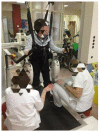Improvement of Gait after Robotic-Assisted Training in Children with Cerebral Palsy: Are We Heading in the Right Direction?
- PMID: 36278529
- PMCID: PMC9624362
- DOI: 10.3390/medsci10040059
Improvement of Gait after Robotic-Assisted Training in Children with Cerebral Palsy: Are We Heading in the Right Direction?
Abstract
Cerebral palsy (CP) is a non-progressive congenital neurological disorder that affects different physical and cognitive functions in children. In addition to standard rehabilitation, advanced robotic gait devices are novel tools that are becoming progressively more common as part of the treatment of CP. The aim of this study is to evaluate the effects of Lokomat training, in addition to conventional rehabilitation, on the motor function and quality of life of children with ataxic-spastic CP (ASCP). Ten children with ASCP who attended the Robotic Rehabilitation OutClinic of the IRCCS Centro Neurolesi "Bonino Pulejo", from April to June 2019, were enrolled in this study. They received twenty-four robotic rehabilitation sessions, twice a week for three months, each session lasting about 45 min. They were also provided with conventional physical and occupational therapy. After the innovative training, we found significant changes in the children's outcomes, i.e., in GMFM (p < 0.001), with significant improvements in sitting (p < 0.03) and walking (p < 0.03). Moreover, the quality of life of the young patients, evaluated by their parents, significantly improved (p < 0.005). The use of robotic systems could be considered to be an effective complementary treatment to improve gait, as well as quality of life, in children with CP.
Keywords: Lokomat; ataxic-spastic; cerebral palsy; gross motor function.
Conflict of interest statement
The authors declare no conflict of interest.
Figures
Similar articles
-
Effect of low dose robotic-gait training on walking capacity in children and adolescents with cerebral palsy.Neurophysiol Clin. 2020 Nov;50(6):507-519. doi: 10.1016/j.neucli.2020.09.005. Epub 2020 Oct 1. Neurophysiol Clin. 2020. PMID: 33011059
-
Effects of robot-assisted gait training alongside conventional therapy on the development of walking in children with cerebral palsy.J Pediatr Rehabil Med. 2020;13(2):127-135. doi: 10.3233/PRM-180541. J Pediatr Rehabil Med. 2020. PMID: 32444570 Clinical Trial.
-
Effectiveness of robot-assisted gait training in children with cerebral palsy: a bicenter, pragmatic, randomized, cross-over trial (PeLoGAIT).BMC Pediatr. 2017 Mar 2;17(1):64. doi: 10.1186/s12887-017-0815-y. BMC Pediatr. 2017. PMID: 28253887 Free PMC article. Clinical Trial.
-
Clinical effects of assisted robotic gait training in walking distance, speed, and functionality are maintained over the long term in individuals with cerebral palsy: a systematic review and meta-analysis.Disabil Rehabil. 2022 Sep;44(19):5418-5428. doi: 10.1080/09638288.2021.1942242. Epub 2021 Jul 7. Disabil Rehabil. 2022. PMID: 34232847
-
Is robotic gait training effective for individuals with cerebral palsy? A systematic review and meta-analysis of randomized controlled trials.Clin Rehabil. 2022 Jul;36(7):873-882. doi: 10.1177/02692155221087084. Epub 2022 Mar 25. Clin Rehabil. 2022. PMID: 35331027 Free PMC article.
Cited by
-
Rehabilitation of Gait and Balance in Cerebral Palsy: A Scoping Review on the Use of Robotics with Biomechanical Implications.J Clin Med. 2023 May 4;12(9):3278. doi: 10.3390/jcm12093278. J Clin Med. 2023. PMID: 37176718 Free PMC article.
-
Evaluation of EMG patterns in children during assisted walking in the exoskeleton.Front Neurosci. 2024 Oct 24;18:1461323. doi: 10.3389/fnins.2024.1461323. eCollection 2024. Front Neurosci. 2024. PMID: 39513047 Free PMC article.
-
The Rehabilitation Interventions and Adaptive Technologies Used for Treating Patients With Cerebral Palsy.Cureus. 2023 Nov 20;15(11):e49153. doi: 10.7759/cureus.49153. eCollection 2023 Nov. Cureus. 2023. PMID: 38130572 Free PMC article. Review.
-
Influence of Robotic Neurorehabilitation in Cerebral Palsy on Motor Function and Gait.Children (Basel). 2025 Feb 6;12(2):190. doi: 10.3390/children12020190. Children (Basel). 2025. PMID: 40003292 Free PMC article.
-
The efficiency and use of a reciprocating system aid for standing and walking in children affected by severe cerebral palsy.Front Pediatr. 2024 Dec 5;12:1447512. doi: 10.3389/fped.2024.1447512. eCollection 2024. Front Pediatr. 2024. PMID: 39703950 Free PMC article.
References
-
- Rosenbaum P., Paneth N., Leviton A., Goldstein M., Bax M., Damiano D., Dan B., Jacobsson B. A report: The definition and classification of cerebral palsy April 2006. Dev. Med. Child Neurol. Suppl. 2007;49:8–14. - PubMed
-
- Eunson P. Aetiology and epidemiology of cerebral palsy. Paediatr. Child Health. 2012;22:361–366. doi: 10.1016/j.paed.2012.05.008. - DOI
-
- Novak I., Morgan C., Adde L., Blackman J., Boyd R.N., Brunstrom-Hernandez J., Cioni G., Damiano D., Darrah J., Eliasson A.-C., et al. Early, Accurate Diagnosis and Early Intervention in Cerebral Palsy: Advances in Diagnosis and Treatment [published correction appears in JAMA Pediatr] JAMA Pediatr. 2017;171:897–907. doi: 10.1001/jamapediatrics.2017.1689. - DOI - PMC - PubMed
Publication types
MeSH terms
Supplementary concepts
LinkOut - more resources
Full Text Sources
Medical
Miscellaneous


